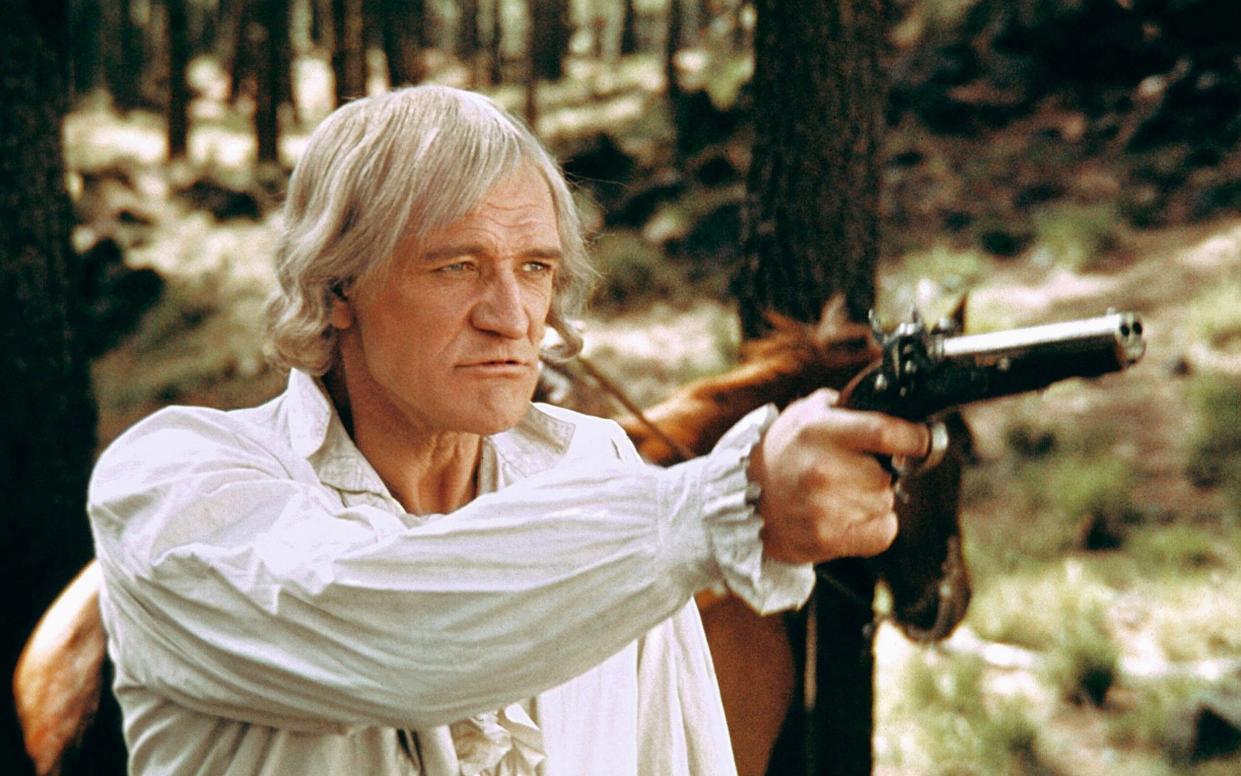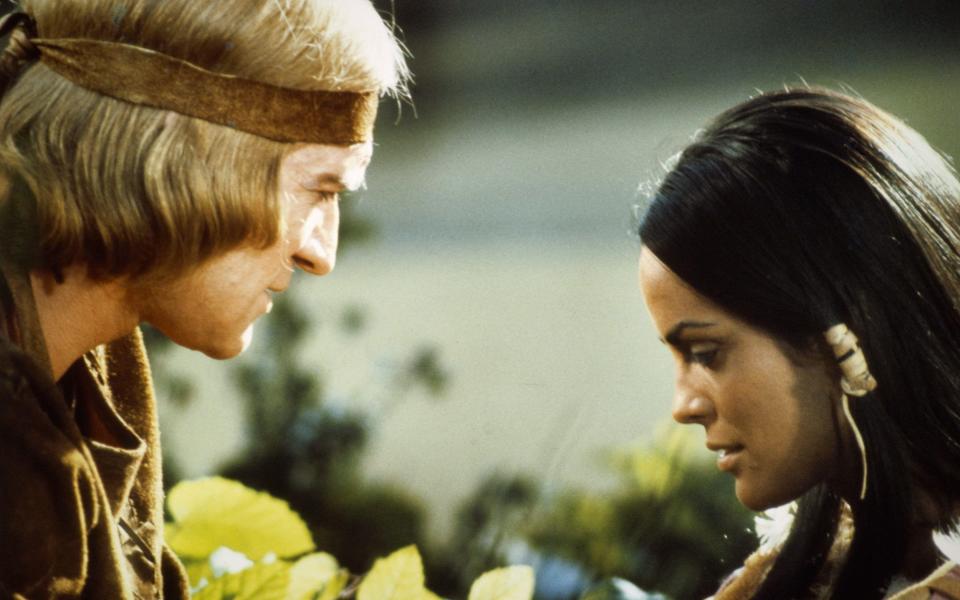Before The English, Richard Harris’s blood-soaked A Man Called Horse stripped the Western bare

- Oops!Something went wrong.Please try again later.
- Oops!Something went wrong.Please try again later.
- Oops!Something went wrong.Please try again later.
- Oops!Something went wrong.Please try again later.
Richard Harris wanted to be the chief of the Sioux Indians. That was one of his demands on A Man Called Horse – a surreal, forgotten, racially-charged Western from 1970. In the film, based in the Dakotas in 1825, Harris plays John Morgan, an English aristocrat who is captured and enslaved by Sioux warriors. Dragged around naked and treated like an animal at first – hence the name Horse (or “Shunkawakan”) – he becomes accustomed their ways and earns respect, through a series of gruesome and gruelling acts, and eventually becomes one of them. In the end, he rides off into the sunset, headed back to Blighty.
But Harris – a towering force of grizzled, unfettered masculinity – wanted to end the film as the actual chief. As detailed in Angela Aleiss’s book, Making the White Man’s Indian, Harris insisted on being presented heroically and he retained approval on script changes that might reduce his role. Harris earned a reputation for an ever-flaring temper and storming off set, and he clashed with director Elliot Silverstein. But it was Silverstein who talked him down from potential chiefdom, persuading Harris to simply ride off triumphantly with a couple of Sioux warriors instead.
It was likely for the best. A Man Called Horse had already whipped up controversy for its portrayal of the Sioux, with criticism from AIM (American Indian Movement) and other Native protesters. “AIM was offended because the white man triumphs and he’s a hero,” says Angela Aleiss, a PhD film historian at Columbia University and former lecturer at UCLA. Indeed, when the film opened in April 1970, there was picketing and even a bomb threat.
Though oddly forgotten – despite two sequels – A Man Called Horse feels like a thematic ancestor of the BBC Western series, The English.
The film was based on a short story by Dorothy M Johnson, originally published in Collier’s in 1950. Producer Sandy Howard read the story while he was laid up sick in Japan. The story had already been adapted for an episode on the television series Wagon Train. “But I saw a potential hit movie,” Howard told Richard Harris biographer Michael Feeley Callan. Howard bought the story rights for a paltry $250. He wanted to cast Robert Redford as John Morgan/Shunkawakan, but Redford was unavailable. Richard Harris was in fact the fifth choice – but the first to say yes.
The film was produced by Cinema Center Film, the theatrical arm of US network CBS. Howard hired Jack DeWitt to write the screenplay and Elliot Silverstein to direct. Silverstein had already sent up the Western with the 1965 comedy Cat Ballou, which had won Lee Marvin a Best Actor Academy Award.
Silverstein wanted Tom Courtenay for the lead role in A Man Called Horse, but he was stuck with the hot-headed Richard Harris. “He had to deal with Harris, he had no choice,” says Aleiss. “Harris was the big name of the movie. I guess the producer Sandy Howard thought, ‘That’s going to sell our picture!’”
There was indeed friction between the director and star. Sandy Howard sided with Harris. Howard thought Silverstein was “a disastrous choice” of director. “Richard Harris was, well, all right to manage,” Howard recalled. “But Silverstein and he just didn’t get on at all… Richard fought with Silverstein; I personally would have killed him. He was a rat and a bad director.”
Silverstein, however, was irritated by Cinema Center Film. The company objected to a humanising scene in which Natives laughed at Harris’s naked body. Silverstein wanted to show “Indians as human beings and not as savage members who prey on white people”. He rankled the studio by speaking out publicly against the decision.

In the original story, the Natives are Crow, but they were changed to Sioux for the film. “Hollywood often changes lesser-known Indian tribes to more popular ones,” says Aleiss, who has written about Native American actors and filmmakers in the 2022 book, Hollywood's Native Americans: Stories of Identity and Resistance. Aleiss also points to Dances with Wolves, whose Indians in the original novel were Comanche – changed to Lakota in the Oscar-nabbing Kevin Costner film.
Members of the Rosebud Sioux tribe in South Dakota were enlisted as extras, though the film was actually shot in Mexico. There was some controversy over other casting choices: some white actors played Natives – including Dame Judith Anderson, playing a tribal elder, Buffalo Cow Head – and Greek model (and former Miss Universe) Corinna Tsopei as Running Deer, the Harris character’s soon-to-be Native wife. Silverstein had wanted the Native Canadian singer Buffy Sainte-Marie for the role, but she declined.
The studio also hired the Rosebud Sioux historian, Clyde Dollar, who was white, as technical advisor. Dollar, an archaeologist and professor of history, was a stickler for accuracy. He raised issues on small details, objecting to which breeds of dog were used in the film, the use of a pheasant instead of a period-correct prairie chicken, even a type of basket used to collect berries. When Harris insisted on wearing a historically inaccurate headband – because his wig made him look like a six-foot Veronica Lake – Dollar loudly opposed it. Elliot Silverstein had to rein him in on the small details. “If scholars are offended by the berry bag then the motion picture has failed because we will have spent not enough time taking their attention to the faces of the actors,” he said. But Dollar was concerned that historical inaccuracy would harm his rep professionally.
At the time, Native Americans tended to be portrayed on screen in a few ways. “Several films of the era featured Native peoples as victims with whites as villains,” said Aleiss, pointing to the grimly violent Soldier Blue, about a massacre of the Cheyenne people, and the Dustin Hoffman-starring Little Big Man, about a white man raised by Native Americans. “On the other side of that era,” says Aleiss, “is the theme of white survival in the wilderness. Films like Jeremiah Johnson, White Dawn, and A Man Called Horse.”

Other films, such as the Burt Lancaster-starring Ulzana’s Raid, about an Apache who goes on a violent rampage, showed “the brutality of Natives with moral ambiguity”. At the time, the Motion Picture Association of America had relaxed its rules of sex and violence in movies. “You had filmmakers experimenting with both,” says Aleiss. “They would sensationalise violence and sell the movie.”
Indeed, scenes from A Man Called Horse wouldn’t have made it onto the big screen a decade earlier. It trots along at a lethargic pace to begin with, as old Westerns tend to do, but A Man Called Horse quickly proves its power to shock – sharply and suddenly. If the sight of Richard Harris on all fours, humiliated and naked, isn’t enough – “Christ, I’ve had enough, you bunch of bloody bastards! I am not a horse. I am not an animal! I am a man!” he wails, Elephant Man-like – his character transgresses with sickening brutality. He earns his Indian stripes by scalping a warrior from an enemy tribe.
In the film’s most shocking scene, Harris’s character endures a Sun Dance ceremony – a sequence that is not for the squeamish. To prove himself a warrior, and worthy of marrying Running Deer, his pectoral muscles are pierced with splints of hardened bone, which are attached to rope. He's hoisted in the air and hangs there, suspended by his own tearing flesh, like a pig on a butcher’s hook. It’s a moment of extreme machismo.
The Sun Dance is a real ceremony, practiced in different forms by various tribes, to reconnect with the earth and the spirits and calls for a renewal of life. As seen in the film, it involved the sacrificial piercing of flesh. The sequence took 14 days to film. For Clyde Dollar, it was the most impressive and most authentic sequence in the film. Native activists, however, took offence. “They objected because showing that ceremony made the Sioux look brutal,” says Aleiss. “It was not shown in a cultural context. He was doing it to prove himself a warrior. That’s not what it’s really about. In Lakota culture, it’s a form of thanksgiving – for success in earlier battles and accomplishments. It’s the fulfillment of a vow or promise.”
Harris’s Man Called Horse ultimately emerges as the tribe’s hero, when he kills a rival chief in battle. But both Harris and Sandy Howard were unhappy with the finished film. It was “a dud”, said Howard. “We previewed it in Oakland and the test audience hated it. Richard had worked his ass off in the desert, portraying this English gentleman who is captured by the Sioux and takes to their ways, but, when he saw what Silverstein had, he wanted nothing to do with it.” They took the film off Silverstein and re-edited it. A Man Called Horse was soon met with controversy.
At the time there was a rise in Native peoples’ activism. AIM was founded in Minneapolis in 1968 and took part in a 19-month occupation of Alcatraz, which lasted from 1969 to 1971. “AIM were protesting discrimination against Native Americans – especially from the police – in Minneapolis and other cities,” says Aleiss. “They were fighting for sovereignty of Native people, which raised issues of reclaiming land, reclaiming culture, and discrimination.”
Ahead of the film’s release, producer Sandy Howard and star Corinna Tsopei faced critics at the AIM headquarters. They were called “sell outs” – particularly for casting non-Indians. One protestor, who was not Native, accused them of making Richard Harris “a Tarzan for the red people.”
“A lot of the offence had to do with Richard Harris's hero,” says Aleiss. “That’s a common theme in films. Run of the Arrow has Rod Steiger as the white guy who goes Indian. Jump to Dances with Wolves, and that’s about a white guy who becomes a hero among the Lakota Sioux.”

Clyde Dollar faced further criticism on a publicity tour. “Why do you show us in this manner?” one Native woman asked him. “This is the image we’re trying to forget.” Dollar noted that protestors were made up of other Native peoples – some of whom were historical enemies of the Sioux – and didn’t understand the cultural nuances of what was depicted on screen. For them to see the depiction of the Sioux as “savage” was expected, thought Dollar. In fact, he considered it a compliment to the film’s realism. As far as Dollar was concerned, members of the Sioux people had given A Man Called Horse their approval, and AIM did not necessarily represent the Sioux.
When the film opened in Minneapolis, protestors formed picket lines and literally blocked cinemagoers from getting to the box office. They called the film “humiliating and degrading”. There was a bomb threat, forcing the fire brigade to investigate. Cinema Center Film had been showing the film to Native peoples for free at first, but stopped – they believed it was creating an unfair reaction against the film. Though the controversy ultimately helped the film’s box office. “When these things happen it draws curiosity,” says Aleiss. “It made $6 million, which today could be $50 million. It did well. Enough to make two sequels.”
Indeed, Richard Harris rode back in 1976 for The Return of a Man Called Horse and again in 1983 for Triumphs of a Man Called Horse. Harris certainly liked the portrayal. “The public has never seen the American Indian as he was before the white man,” he said in one interview. “In this movie, we see the truth.”

